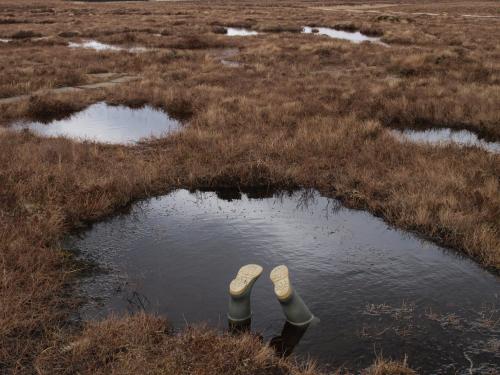In this project we looked at what makes people care about peatland restoration. Peatbogs are important because of their ability to store carbon, regulate water flows and provide a home for rare species of plants and animals. Nevertheless, peatbogs are often described as a hard-to-love ‘Cinderella habitat’. Focusing on care can add further insights into why people care, support and do peatland restoration.
Our results (paper currently in review) highlight the importance of personal experiences and relationships with peatbogs to develop an appreciation for peatbogs. The results also point to different perceptions of what it means to care for peatbogs and difficult questions about how to find the right balance between protecting peatbogs and engaging people with them.
Successful peatbog restoration therefore requires structures (e.g. flexible funding schemes) which can support restoration while also enabling people to care for and interact with peatbogs and learn through experience.

Stage
Purpose
Peatbogs are a prominent part of the Scottish landscape covering approximately 20% of Scotland’s land surface. While most people associate peatbogs with getting wet feet (or peaty whisky), they are also home to specialist plants and animals which are often not found elsewhere (such as the carnivorous sundew plant). In addition, peatbogs help to regulate water flow and thereby prevent flooding and to store carbon.
As a large proportion of Scottish peatbogs have been degraded to some degree they are in need of restoration. In this project we looked at what makes people care for peatbogs which have been described as an unloved Cinderella habitat and what factors influence people’s capacity to take care of peatbogs.
Results
We conducted two workshops, one in a rural area and one in a near-urban area, interviewed 28 people involved in peatbog restoration in different ways (in a professional role, volunteers/local community members and land owners/managers) and who took part in volunteering activities in peatbogs.
Our results highlight the importance of personal experiences and relationships and embodied learning in fostering care and defining what it means to care for peatbogs.
Our results also point to difficult questions about what it means to care well and factors which can limit people’s capacity to take care of peatbogs. These include lack of access and ownership, lack of experience and knowledge, time and resource constraints and the variable nature of peatbogs.
In addition, given the importance of personal interactions in fostering understanding and care for peatbogs this can also lead to dilemmas about how to find the right balance between on the one hand promoting people’s use of peatbogs (whether for recreation, peat cutting or grazing) and thereby foster their relationship with bogs while on the other hand protecting peatbogs from negative impacts of human use.
Our study also showed that appropriate structures (e.g. in the form of flexible funding schemes) can allow for the joint creation of knowledge and caring practices between experts, lay people and peatbogs through experimental practices, experiences and reflection.
Benefits
Our research shows that many people do care about peatbogs, but that opportunities to interact with peatbogs are a prerequisite for people to develop an appreciation for peatbogs. This highlights the importance of creating opportunities for people to interact with peatbogs.
In order to achieve successful restoration of peatbogs it is also important to support those who already care for peatbogs to overcome some of the barriers to restoration in the form of, for example, limited resources, access issues, time limits in funding schemes, learning opportunities and flexibility.
Creating the right kind of supportive environment for peatbog restoration and people’s engagement with peatbogs can enhance people’s well-being and appreciation as well as improve the status of Scotland’s peatbogs helping to ensure that they can continue to support regulating water flows, storing carbon, providing a home for biodiversity and enhancing people’s connections to nature.